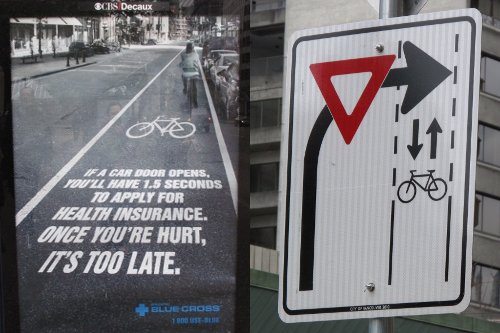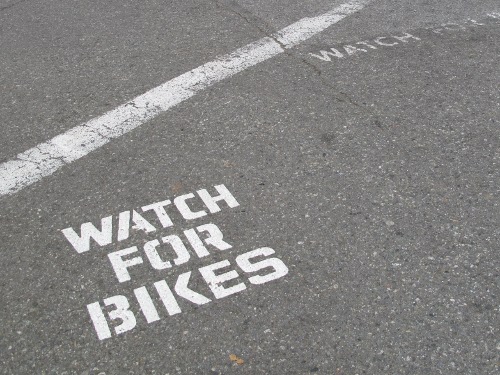So here's a thought from psychology and parenting. If someone feels unsafe or scared or intimidated or anxious, let's acknowledge it. They own the feeling. Not me/you/us, not the world, not the other people in the world. Let's not say: "Well, you shouldn't be." It may be true, but there are other sides to it: it's kind of rude, it doesn't really work, and there's a good likelihood that they'll be either offended or annoyed.

The reality is that when riding on roads on lanes shared with cars, it's not a gigantic leap that many people will feel any or all of the above. Sometimes I am scared. I was more scared in the beginning (by almost everything except the seawall) and now I am not scared as much. I'm still scared when I have to merge across lanes of full-speed car traffic in order to turn left.
A sixteen-year old might be scared the first time they leave the parking lot and drive on a real road. Someone who has grown up in a rural area might be scared the first time they visit a big, bustling city. A grown adult might be scared when they first ride a bicycle in the same space as cars, trucks, buses, and motorcycles.
All these people may be scared because they do not feel safe. Within this feeling unsafe is (a) your own comfort level and familiarity with the activity, (b) your knowledge and factual information about the activity, and (c) the environment that the activity is performed in. (Note: not an exhaustive list.)

Cycling may be safe enough in certain scenarios that specialized protective equipment is not necessary. (---with "certain scenarios" being a combination of the environment supporting the cycling and the cyclist's personal skill/knowledge.) There is currently great disagreement about whether this is true and which in what context.
There are many ways we can change whether cycling is safe enough and whether each individual feels safe while doing it. However, while they are related goals, they are not the same.
Do I need to repeat that?
Do I need to bold or CAPITALIZE it or put it on its own line so that I don't forget it?
Safe enough and feeling safe are not the same.
Some of the current initiatives for change are: creating separated infrastructure (thank you, City of Vancouver); providing education and training for those who don't want to build comfort and familiarity independently (thank you, VACC); raising awareness of existing bike cultures with low cyclist injury rates (thank you Copenhagen Cycle Chic). I'm sure there are about a million more and I would love to sit down and do some research and creative idea generation, but that needs to be left for another time.

Today I'm all italicized out.
When I first started cycling (at 16), I was nervous and scared. I would usually ride on the sidewalk because of this, plus there was no such thing as a bike lane in this city and such few people would cycle. Also I never rode a bike when I was a child so it was all a new experience.
ReplyDeleteFast forward to today, I am only nervous when I'm riding in a city that I'm not familiar with and doesn't have wide roads or bike lanes.
I don't FEEL unsafe riding in this city. They have provided a decent amount of on-street bike lanes which helps.
The on-street bike lanes however don't actually make cycling any safer. A driver can be distracted or have a medical condition and they may lose control and drive right into the bike lane.
I was really upset when the roads were redone and the city opted not to put in separated bike lanes, despite having ample amount of space.
There has also been a large increase in the number of people riding bikes and this helps mainly because motorists get use to us and know how to pass properly and safely.